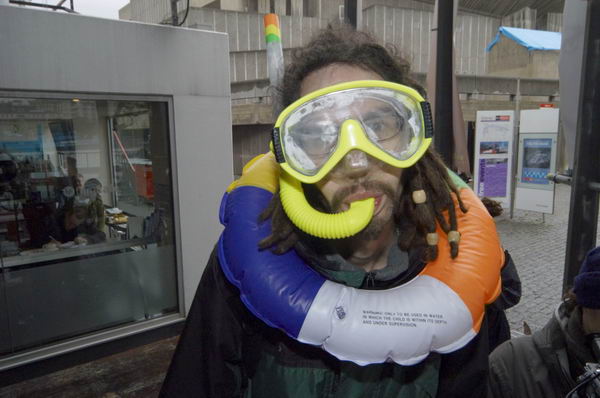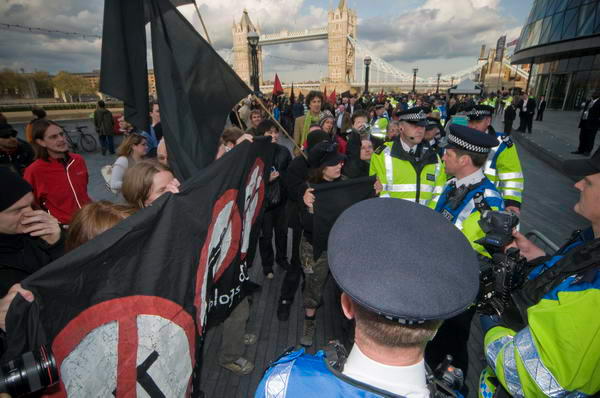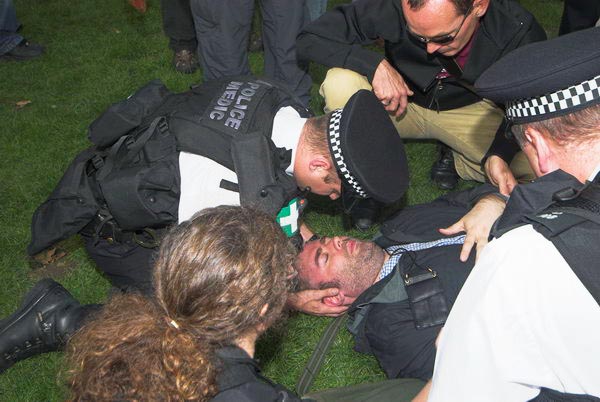
In October 2004 I wrote the following on My London Diary while covering the European Creative Social Forum‘s London Underwater 2050 Tour of the G8 Climate Criminals:
worrying was the deliberate police use of photography as intimidation, with the police photographer going out of his way to confront demonstrators, aided by two other officers.
i worry because i think it is an attempt to attack civil liberties, but also because such behaviour makes all photographers suspect. i can only work effectively if i gain the trust and cooperation of those whose pictures i take. perhaps it helps that photography is one of the activities that also arouses suspicion and intimidation by the police.
as i walked away at the end of the demonstration, this team ran 50 yards down the road and caught up with me, one calling “excuse me, sir” and tapping on my shoulder. i turned to face him, and found myself looking into the lens of the police photographer, who took my picture as his colleague started to question me about who i was taking pictures for. it seemed clear and deliberate harassment, intended to intimidate a photographer acting entirely lawfully, photographing on the public highway.
This was the first time that I’d come across the police use of photography in this way, and I was worried by it. Now it’s commonplace and few demonstrations take place without police harassing demonstrators in this way, without Fitwatch confronting the police FIT teams, and without police harassing photographers.

Fitwatch confronts the police FIT team at City Hall, May 2008
Like Marc Vallée, I was also photographed by police at the City Hall demonstration last Friday, while I was engaged in the subversive act of sitting on a wall and reading a book. I ignored them, but he had a long stand-off, camera in front of his face before the event, and also found the police camera pointed at him from close range later in the event. You can see his pictures on his blog.
An e-mail today pointed out to me a Guardian article: Police should harass young thugs – Smith by political editor Patrick Wintour, in which he reports home secretary, Jacqui Smith as urging police forces across the country to mount “frame and shame” operations stopping and photographing “identified persistent offenders on problem estates.”
The police have already used such tactics to photograph 14 young poeple “known to the force” on estates in Basildon. Wintour quotes a police spokesman:
“The aim is to target a small group of persistent offenders by openly filming them, knocking on their doors, following them on the estate and repeatedly searching them, as well as warning them in no uncertain terms that local people have identified them as lawbreakers.”
Smith is quoted as saying she wants “to create an environment where there is nowhere to hide.” I immediately think of Orwell’s ‘1984‘, although current-day surveillance techniques have perhaps outstripped anything he envisaged. As the article says, there may be “human rights issues about such tough tactics, especially if those harassed by the police have not been found guilty of any criminal offence.”

Marc Vallée receives medical attention after being injured by police in Parliament Square, October 2006.
Photography is not yet a criminal offence, indeed I have a letter from an officer of the Metropolitan Police confirming my right to photograph in public, written after a rather unpleasant encounter when two police threatened to fit me up around ten years ago. So far as I’m aware, Marc’s only offence has been to allow himself to be assaulted and injured by police, for which he received an out of court settlement earlier in the year.
This really is rather dark and worrying. What possible legitimate policing requirement justifies this monitoring? The clear implication is that the material shot is being investigated by a backroom team, establishing identities and profiling behaviour of photographers observed covering events.
I could hazard a guess that FIT teams are gathering intelligence to assist increasing restriction of the National Press Card. Which as we know is a live issue between the police and the NUJ and other gatekeeper organisations. Will ‘unfavourable’ intelligence lead to veto of photographers? Will police intelligence form part of the (outsourced) vetting procedures? Or will the issue of NPC’s to individuals whom the police considers problematic on the strength of FIT monitoring lead to insistence that the whole scheme be managed directly by the police?
Or is it just aimed at deterring coverage? Or both?
The police do at times seem to make a distinction between what they see as the legitimate press and the rest – with organisations like Indymedia being very much the rest, and freelances at best doubtful – even when commissioned by the commercial press. They also at times appear biased against those with NUJ issued cards.
I think some officers clearly think that photographers incite protesters and that they would rather we were not there on some occasions. When I photographed a march by football supporters a year or so back, they came up and talked to me, photographed me and then made it very clear that if I continued to take pictures I might well be at risk from the supporters – and suggesting that this would not greatly worry them.
I’ve had a few odd experiences too. One afternoon last year I did spend around half an hour walking around London with two uniformed officers following about 20-30 yards behind me – I deliberately took a rather wandering route to be sure I was being followed, then jumped on a bus and lost them. And on several occasions I’ve seen police pointing me out to each other as I’ve passed. They do obviously spend some time looking at those pictures. Marc and others who photograph protests have similar stories to tell.
The press card often isn’t a great help, but I would be unable to cover some of the events I do without risk of arrest without one.
Quote “but I would be unable to cover some of the events I do without risk of arrest without one.”
So if I was photographing without a press card on what grounds would I be arrested, I presume the catch all “obstruction” but to what point from the police point of view ?
Do demonstrators ” play up” to the cameras ? Do you feel you are, at times, influencing what happens when only there to record ?
If you don’t have a press card you will be treated by police as a demonstrator whether you are or are not demonstrating. If you are lucky you may be given the option to leave the area. But even if you are there with a card you can still get attacked in various ways by the police – quite a few colleagues got hit by batons during the torch rally. I just got jostled a bit where I was, but earlier in the year I had a photographer thrown bodily at me by the police at Downing St!
Arrest could be obstruction, or SOCPA or one of the terrorism acts. They really are not too particular. Mostly they hold people for a short time and then release them without charge in any case, but you can’t rely on it. Even with a press card I’m often – probably on average once a month – threatened with arrest by the way, sometimes you just have to back off. I’m probably better than most at avoiding confrontation.
Certainly the presence of media recording events can alter what is happening. At the most basic of levels I often have to tell the people I’m photographing to keep on doing whatever it was rather than stopping and smiling. But I try hard not to alter things, although many press photographers actually set things up for pictures.
A couple of weeks ago I was photographing an event and another photographer came up to me, obviously rather upset, complaining that the event organiser had complained about the way that photographers were getting in the way and taking over the event. I try very hard not to do so, although I also want people to be aware that I’m there and taking their pictures, and on that occasion I don’t think there were any complaints about me.
Of course a lot of events are created with the media in mind, though I usually don’t bother with ‘press calls’ etc and my ideas of what would make a good photograph are seldom the same as the people who set such things up.
I’m in the fortunate situation that I can photograph what I like and not worry too much about what other people want, and know even if I won’t get rich, I won’t starve.
Yesterday I heard a photographer kind of apologising about the fact that the papers had used a picture of his of Ken Livingstone looking very silly (it was a rather striking picture.) I made sure that the only pictures of Ken I supplied were ones that I was happy with. Only one of mine was used over the election, and though I’m disappointed that some of the others weren’t used I’m sure some will get used in other ways in the future.
Thanks for that. Out of the metropolitan area we are ignorant, generally, of these issues. I had a business for many years adjacent to the local town hall, provincial city, and witnessed many demonstrations including miners strike, although not in that area, and poll tax. These were unfailingly good natured affairs with only the occasional hot head (on the demonstrators side) giving trouble.
My admiration for the “press pack” grows.
http://www.bjp-online.com/public/showPage.html?page=801977
Thoughts ?
Well, it’s a comment from the same Home Secretary who is encouraging police to use photography to harass ‘troublemakers’ on estates, so I don’t have great expectations of her.
But her statements:
“the Government greatly values the importance of the freedom of the press, and as such there is no legal restriction on photography in public places,” and “Also, as you will be aware, there is no presumption of privacy for individuals in a public place.” are both I think useful ones to make at this time.
What she then goes on to say is rather less so, particularly when she fails to say under what laws officers might make their operational decisions, rather presenting it as something that they can make arbitrary decisions on, which is misleading at best. We don’t yet live in a police state as she seems to suggest.
However, the piece by Robert Grey in the Press Gazette is worth reading:
http://www.pressgazette.co.uk/story.asp?sectioncode=1&storycode=41516&c=1
Photographers are having some arguments about this and how best to improve things – with some resentment being shown at the way that some NUJ members have been taking things forward.
Have you seen Marc Vallée’s blog on this:
http://www.marcvallee.co.uk/blog_020708.html
I think I posted a link to the slide show before – there are a couple of my pics in it – but he makes his comments on Smith’s letter below.
Peter
Yes “operational decisions” seems to be a convenient catch all.
Marc’s blog is always informative .
But more potentially bad news here I’m afraid.
http://photorights.org/blog/42-days-and-hand-over-your-flash-card
I think that the ‘reasonable suspicion’ needed will act as some disincentive for police to use s43 powers – they would I think be likely to get caned by the courts if they failed to use them with at least some justification. This piece is unusually sloppy thinking for Tony in my opinion, for example the reference to Marc’s hospitalisation. I didn’t see the actual event – I was on the other side of the melee, but I have seen a video that captured it (and of course I did photograph Marc after the event – my pictures from the event are at http://mylondondiary.co.uk/2006/10/oct.htm and give some idea of the atmosphere).
But Marc was only one of a hundred or so photographers there and although many of us were jostled and I don’t think the police behaved in an appropriate manner towards either photographers or demonstrators on that occasion I don’t think it justifies the way that case is referred to there.
Peter